 |
|
 |
|
 |
|
 |
|
| Diving in Aruba: When we first went to Aruba diving was not the popular sport it is now. Dive shops were few and far between. When I approached one to inquire about my getting certified in the week's time we had, I was told it was impossible. With the growth of the sport in the late 80's and early 90's diving has taken off in Aruba and dive shops are plentiful today. Most hotels have a dive program sponsored by their own dive shop or through an affiliation with a local dive shop. Boat dives: Many of the best dive sites can only be reached by boat. The surf is always choppy so be prepared for it. And, please, if you begin to feel a bit sick to your tummy ... DON'T share the news with the rest of the people on board. It's amazing how everyone is just fine until that one person announces they aren't feeling well. That announcement makes everyone feel bad, so, please, keep your mouth shut. Be sure to visit the Airplanes, The Antilla, Jeanne C., and tug boats. There are also several good places where you can do drift dives. Shore dives: There are several good shore dives you can enjoy, among them, Baby Beach, Rocky Beach, and Mango Halto. Entry can be somewhat difficult on some dives because of a rocky bottom so make sure you have booties. Be aware of the currents for your dive site as they can at times run pretty strong. Now, let's look at some underwater pictures taken in Aruba's waters. |
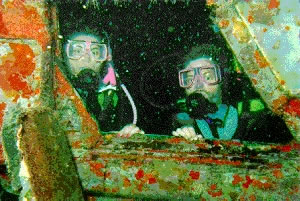 |
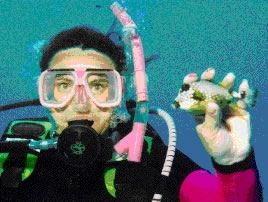 |
|
| Anne and I peering through the cockpit window of the DC-3 at the Airplanes dive site. | Anne holding a small Spotted Trunkfish that we caught while diving at Baby Beach. |
 |
Caribbean Lobsters are abundant in the waters around Aruba, but they seem to be of the smaller variety and not like the large ones we found in the British Virgin Islands. |
| This little fellow couldn't escape our grasp at Baby Beach. We finally caught one! And, yes, we let it go immediately. We held it just long enough to get a couple of good pictures with him. |  |
 |
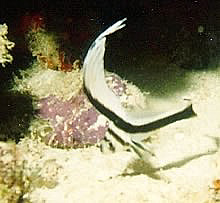 |
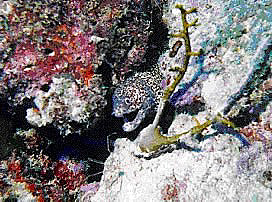 |
| Spotted Eel | Juvenile Drum Fish | Spotted Eel |
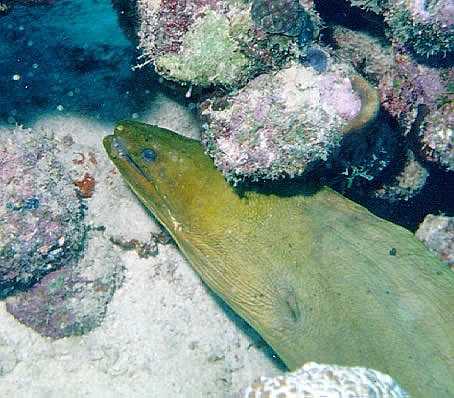 |
Large Green Moray Eels can be easily found around Aruba. This guy was hiding in a hole, naturally, and I set up waiting for him to peek out so I could get a good head shot. I waited and he stayed right where he was. Then Anne, brave little Annie, saw his tail coming out of the other end of the hole. She rubbed him and the next thing I knew he was looking out at me. I got this once chance for a picture and that was it. |
| Southern Stingrays are also common around Aruba. This one was concealed on the bottom and covered almost completely with sand. Anne, known for her "eagle eyes," spotted him first and called my attention to him. As I moved in to take the picture he began to scurry off but not before I got this picture. |  |
 |
 |
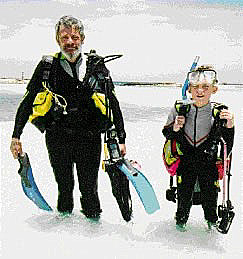 |
| Anne with Heime. Heime is the diving instructor that certified me. He now runs his own dive business. Give him a call if you're interested in learning how to dive. If you see a flyer for Scuba Plus pick one up, that's Heime. | A White-spotted Filefish in its orange phase. | Breaking in the next generation: my my nephew, Paulie, after his first exposure to SCUBA at Baby Beach. |
| Sorry there aren't more pictures of tropical fish and other underwater
life, but the truth is that most of my diving in Aruba was in my "pre-camera"
days. Since purchasing the underwater camera we've done little diving
in Aruba so there are only a handful of shots to choose from. Maybe next
year I'll be able to add more to the collection. |
| Previous
page
| Next page |
| Links
to other ABC Island album pages |
| Aruba:
About Aruba | Timeshare
Living In Aruba | Island Sights | More
Island Sights | Curacao | Bonaire
|
| Links
to other Anniebee's web site pages Anniebees Home Page | Annie's Kites | Drewry Family History | Vacation Paradise | Web Design Services |